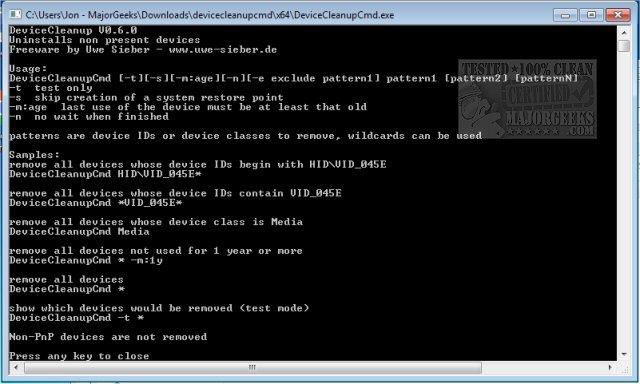The Device Cleanup Cmd is a command-line utility designed to assist users in removing residual entries of non-present devices from the Windows device management system. Each time a device is connected to a computer, it leaves a record in the system, which can accumulate over time. While these entries can be manually deleted through the Windows Device Manager, this process can be cumbersome, especially when there are numerous entries.
Device Cleanup Cmd streamlines this task by enabling users to select and remove multiple device entries simultaneously, similar to the graphical user interface (GUI) version of the Device Cleanup Tool, but through command-line operations.
- `-t`: Executes a test to show which devices would be removed without actually deleting them.
- `-s`: Skips creating a system restore point during the operation.
- `-m:age`: Sets a minimum age for the device usage; only devices that have not been used for the specified duration will be removed.
- `-n`: Indicates that the command should not wait for the operation to complete before returning control to the user.
Patterns can include device IDs, device classes, or friendly names, and wildcards are supported for flexible matching.
Conclusion:
The release of Device Cleanup Cmd 1.5.1 provides users with an effective solution for maintaining a clean and organized device management system. Whether you're a tech-savvy user or someone who prefers command-line tools over graphical interfaces, this utility is designed to simplify the management of device entries in Windows. As technology progresses, tools like Device Cleanup Cmd will continue to evolve, offering even more features and enhancements to improve user experience
Device Cleanup Cmd streamlines this task by enabling users to select and remove multiple device entries simultaneously, similar to the graphical user interface (GUI) version of the Device Cleanup Tool, but through command-line operations.
Usage Instructions:
The command syntax is as follows:DeviceCleanupCmd pattern1 [pattern2] [patternN] [-e:excludepattern1] [-t] [-s] [-m:age] [-n]- `-e:excludepattern`: Specifies a pattern for devices that should not be removed.
- `-t`: Executes a test to show which devices would be removed without actually deleting them.
- `-s`: Skips creating a system restore point during the operation.
- `-m:age`: Sets a minimum age for the device usage; only devices that have not been used for the specified duration will be removed.
- `-n`: Indicates that the command should not wait for the operation to complete before returning control to the user.
Patterns can include device IDs, device classes, or friendly names, and wildcards are supported for flexible matching.
Example Commands:
- To remove all devices with IDs starting with "HIDVID_045E":DeviceCleanupCmd HIDVID_045E*- To remove devices containing "VID_045E":
DeviceCleanupCmd *VID_045E*- To exclude specific Bluetooth devices (e.g., COM9 and COM10):
DeviceCleanupCmd BTH* -e:"* (COM9)" -e:"* (COM10)"- To delete devices that haven’t been used for over a year:
DeviceCleanupCmd * -m:1y- To view the devices that would be removed without actually deleting them (test mode):
DeviceCleanupCmd -t *
Additional Notes:
Non-PnP devices are not subject to removal by this command. For users looking to manage their devices more efficiently, this command-line tool offers a powerful alternative to the traditional GUI methods.Conclusion:
The release of Device Cleanup Cmd 1.5.1 provides users with an effective solution for maintaining a clean and organized device management system. Whether you're a tech-savvy user or someone who prefers command-line tools over graphical interfaces, this utility is designed to simplify the management of device entries in Windows. As technology progresses, tools like Device Cleanup Cmd will continue to evolve, offering even more features and enhancements to improve user experience
Device Cleanup Cmd 1.5.1 released
Device Cleanup Cmd is the command-line version of Device Cleanup Tool meant for helping remove leftover traces of nonpresent devices.


